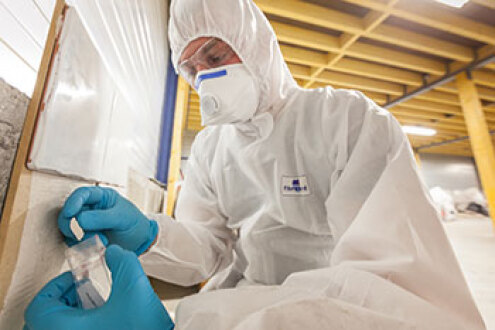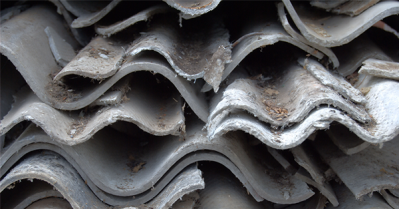Domestic Asbestos Survey




- Asbestos could be present in any pre-2000 building and it kills thousands of people each year.
- A home buyers asbestos survey will be recommended if your home buyers report or building survey flags signs of asbestos in the property
- The average asbestos survey cost depends on the property. Our asbestos report cost starts at £375.00 EX VAT.
Asbestos prohibition laws in the UK were first introduced in the mid-1980s. In 1985 the UK banned the import and use of blue (crocidolite) and brown (amosite) asbestos, and its use was fully banned in 1999.
This means if your property was built 1980's and older, it could have asbestos-containing materials. Landlords are often advised to assume that asbestos is present in all pre-2000 buildings.
How dangerous is Asbestos?
According to some estimates, in 2021, 2268 deaths were linked to Mesothelioma, a rare and aggressive form of asbestos-related cancer. 2500 deaths were also recorded for asbestos-related lung cancer.What does an asbestos surveyor do?
An asbestos survey is an intrusive inspection where a specialist surveyor, wearing protective clothing, removes samples of the suspected asbestos-containing materials to take away for further analysis.
In the report, the surveyor states the type(s) of asbestos found, how it can be removed and, depending on the survey provider, gives an estimate of how much asbestos removal will cost.

This survey physically tests the suspect material, whereas a RICS surveyor does not test during their inspection.
For prospective residential home buyers, both the RICS surveys (Level 3: Building Survey and the Level 2: HomeBuyer Report) will flag up signs of asbestos and recommend an asbestos survey. If you already know there is asbestos, then you should go straight for a specialist survey.
Asbestos can be highly dangerous: inhalation of asbestos dust can result in lethal health conditions, including lung cancer, mesothelioma and asbestos.
You are well advised to book an asbestos survey if your home buyers survey advises you to do so.
For freeholders, asbestos risk assessments and fire risk assessments, particularly at the beginning of a change of ownership, run together. Asbestos surveys are done first as best practice because the latter might accidentally result in a highly dangerous disturbance of existing asbestos in a building.
How do I get an asbestos survey?
You will need to instruct a qualified surveyor to carry out the survey on your property and draft a report. Whether you're looking to buy a flat - or looking to buy a block of flats - if you have concerns about asbestos, a survey will clarify what your risk is and what action, if any, needs to be taken.If you're looking to buy a flat block, getting a survey, depending on the age of the block, might be a legal requirement.
BOHS Qualified Surveyors | Same Week Availability* | National Coverage | Reports within 5 Working Days** | Terms Apply
What is Asbestos?
Asbestos is a naturally occurring fibrous mineral. It was a commonly used building material, particularly as part of cement products, floor tiles and roofing shingles where its durability and resistance to heat were highly valued.
The strength and microscopic nature of its fibres, however, make it very dangerous when inhaled, with the potential to cause life-threatening ailments which sometimes take some years to show symptoms.
Whether any action needs to be taken - for example, complete removal by specialists - depends on the type of asbestos detected, its volume and whether dust particles are likely to be liberated, for example, by renovation/decoration at some future point.
There are six different types of asbestos of which crocidolite, or blue asbestos, is considered the most hazardous. The six types of asbestos are Chrysotile, Crocidolite, Amosite, Tremolite, Anthophyllite and Actinolite.
What are the different Asbestos Survey types?
Currently, there are two types of asbestos surveys. The types of survey are called - Type 1 and Type 2 or Asbestos Management Survey (Type 1) and Refurbishment and Demolition Surveys (Type 2).
You need to decide whether you are looking to maintain the asbestos so as not to cause damage to it and release the dangerous fibres into the air or if you are looking to get the asbestos removed entirely (normally because you are completing building works).
Type 1 Asbestos Management Surveys
After an intrusive investigation, management asbestos surveys give direction on how to protect against any risk without any major removal action.
Type 2 Refurbishment and Demolition Asbestos Survey
After a detailed, more intrusive survey and a comprehensive assessment, these surveys give directions about where asbestos detected has to be removed or whether it can be managed.
What is the Residential Asbestos Survey Cost?
The cost of asbestos surveying depends on a few factors, particularly on the size of the property. Our asbestos report cost starts from £375.00 EX VAT for a standard construction, up to 4 bedroom property and progress upwards from here.
The asbestos survey cost for a freeholder/landlord/managing agent of leasehold flats varies according to many factors, particularly the extent of the block/s and the type of flats involved.
How much does it cost to get Artex tested for asbestos?
Artex ceilings can contain asbestos if built pre-1999. For this reason, you will still need to instruct a surveyor to take samples and do a risk assessment. The cost will start at £375.00 EX VAT.
Who is responsible for an asbestos survey?
Who is responsible for managing asbestos matters in flat blocks?
The person responsible for managing the maintenance and repair of common areas in buildings containing flats also bears the legal responsibility to manage safety matters regarding asbestos.
This would, therefore, normally be a Responsible Person appointed by the managing agent on behalf of the landlord/freeholder or the Right to Manage company, and they are legally required to be competent.
Their essential duty is to carry out a robust asbestos risk assessment of the areas they are legally required to (see below), to write this up, act on any action points made, store it and review it regularly.
Additionally, under Regulation 4 of the Control of Asbestos Regulations 2006, landlords have duties towards their tenants to minimise the risks of asbestos exposure.
It is a criminal offence if they are found to be negligent in doing this; for example, if a managing agent hires a contractor to repair a porch and the contractor ends up disturbing asbestos which was not previously noted in the assessment, the landlord can expect a large fine and/or imprisonment.
This requirement is in the Control of Asbestos Regulations 2012 but it applies only to common areas. However, common areas can be quite extensive, including:

- Foyers
- Corridors
- Lifts and lift shafts
- Staircases
- Boiler and plant rooms
- Store rooms
- Roof spaces
- Gardens
- Yards
- Outbuildings
- Garages
- Sheds
- Bike shelters
Common areas within one private residence shared by more than one household, e.g. bathrooms and kitchens in shared houses and communal lounges, are not included.
Asbestos regulations are enforced by the Health and Safety Executive and local authorities.
Recovery of the asbestos survey cost and the necessary work resulting from this is based on similar principles as set out for fire safety.
The lease may specifically allow for recovery as a service charge or the freeholder may be able to bring the cost within what is known as a "sweeping up clause".
It is beneficial to leaseholders to have these checks because, on the sale of a flat, the buyer's solicitors will ask for confirmation that a home buyer's asbestos survey and fire safety check have been carried out and ask to see evidence of this. It may cause a problem with a sale if this is not available.
As a general rule, landlords should assume that any building built prior to 2000 might contain asbestos.
What does the Health and Safety Executive expect of landlords regarding asbestos (asbestos risk assessment)?
The HSE broadly expects the following:
- Find out if asbestos is present at the premises
- Presume material is asbestos until proven otherwise
- Survey and sample for asbestos
- Assess the condition of the asbestos-containing material
- Record where the asbestos or presumed asbestos is and its condition. Put together a drawing or plan of its location.
- Assess the potential risk of the asbestos and whether it’s likely to be damaged or disturbed
- Decide what to do
- Take appropriate action
- Check what's been done
- Monitor and review the effectiveness of the plan
Only specialists should handle asbestos. If it's identified on-site, what should happen then depends on what state it's in.
If it's in good condition, then:
- It should continue to be monitored at regular intervals
- It should be labelled where practical
- All contractors or workers who might likely disturb any asbestos must be informed of its actual and possible presence
If the asbestos has had minor damage:
- The material should be repaired and stabilised/encapsulated
- It should continue to be monitored
- It should be labelled where practical
- All contractors or workers who are likely to disturb any asbestos must be informed of its actual and possible presence
If a domestic asbestos survey reveals that the asbestos is in poor condition, it should be removed and safely disposed of by appropriate professionals.
Worried about Asbestos?
Whether you're looking to buy a flat - or looking to buy a block of flats - if you have concerns about asbestos, you can get a domestic asbestos survey report to clarify what your risk is and what action, if any, needs to be taken.BOHS Qualified Surveyors | Same Week Availability* | National Coverage | Reports within 5 Working Days** | Terms Apply
Andrew started his career in 2000 working within conveyancing solicitor firms and grew hands-on knowledge of a wide variety of conveyancing challenges and solutions. After helping in excess of 50,000 clients in his career, he uses all this experience within his article writing for SAM, mainstream media and his self published book How to Buy a House Without Killing Anyone.
Caragh is an excellent writer and copy editor of books, news articles and editorials. She has written extensively for SAM for a variety of conveyancing, survey, property law and mortgage-related articles.









